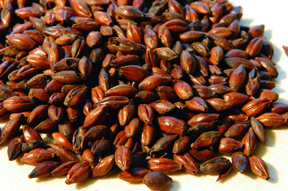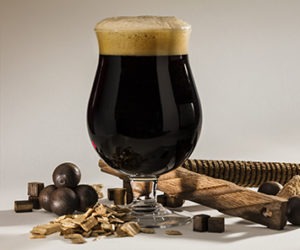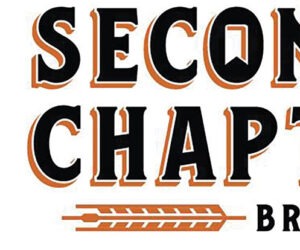Brown Malt

During the mid-Nineteenth Century, brown malt was still widely used but was being specifically employed for its character (e.g. as a specialty grain) rather than its fermentable product. Using less brown malt reduced the character of the beer and it was left for the brewers to develop other ways to mimic the flavors and color of brown malt. Most were sugar-based (blackening of sugar), but some were roasted malt husk products, as we see in use today. Most of these increased the color, but did little to produce the astringency that one gets from brown malt. Brewers used many different spices ranging from coriander to grains of paradise, but more prominently licorice. Sugar-based molasses and treacle products and a malt-derived concoction called essentia bine were the most common for adding both flavor and color to the beers. The death knell for brown malt was sounded with the creation of black patent malt in 1817. Although its use continued into the Twentieth Century, most brown malt had been replaced either by black malt or by various sugar substitutes.
Malting
Most brown malt made over the last 200 years has been of the non-enzymatic type. Originally brown malt was made from green malt. The green malt was removed from the withering floor (e.g., germination floor) earlier than regular ale malts. It was then spread out thinly over the tile floor of the kiln and heated moderately until approximately half the moisture was removed. The malt was then “blown,” the process by which brown malt receives all its peculiar qualities in the kiln. Simply, escaping steam puffs up the kernel and the continued high heat sets the kernel. This is accomplished by adding either straw or hardwood (oak or beech) to the kiln so the temperature climbs to over 200 °F (93 °C). This process was more expensive than making pale malt, due to fuel and labor. On top of this, it reduced the extract by approximately 20%.
Brown malts were originally dried with straw, wood and fern. Straw dried was by far the best, being used for only the best malt. Wood had a tendency to lend a harsh smoke quality and lesser quality malt was usually used for the wood-dried brown malt. It was common practice to use a great quantity of hops and to age the beer made with wood-dried brown malt 9–12 months to rid the beer of the unwanted smoke character. Fern dried malt was the worst, lending a tarry character to the malt, but for a period of time it was the most widely used because it was cheap and plentiful. This leads us to a very specific question. Did brown malt have a predominant smoke character? The accounts are quite spotty, but it seems that beers made with brown malt did not have an overt smoke character. On the other hand, the smaller brewers who malted their own grains did seem to have a smoke character in their brown malts.
As the use of coke became prominent, the way brown malt was produced and its character changed. The invention of the drum roaster nearly completes the progression of brown malt to its current form. It was roasted in a perforated cylinder in a cast iron casing. A low coke fire was employed and turned slowly and held at approximately 220 °F (104 °C). After steam escapes, the fire is increased, the malt is blown and the kilning continued until the desired temperature (320 °F/160 °C) was reached. Today’s brown malt is made in a much simpler way. It’s made in a direct heated rotating drum where the heat is brought up to around 266 °F (130 °C). The final time and temperature are based on the specifications of the customer. The malt is no longer blown, so will have less of the acrid bitterness that was once associated with the malt. Modern brown malts range in colors from 50–75 °L.
Historical Use
As was stated before, brown malt first began as a base malt that was used up to 100% in some beers. That being said, brown malt made its biggest contribution in porter and stout brewing. But was it used more in porter or stout because they are completely different, right? Historically, there really is no blanket statement that can be made between the difference of porter and stout. Stout most definitely derived from porter, but wasn’t always a “stouter” version of porter (although most definitely could be). More specifically there were brown stouts and black porters! This came as an utter shock to me as I thought the things that I read, taught and consequently preached, were thoroughly researched. Much to my dismay this is not the case. Throughout the 1800’s brewing manuals used these terms as equivalents and verbiage depended on the author’s opinion and by brewery. Styles are only meant to be a snapshot in time and change as does everything in popular culture.
A mid-Nineteenth Century recipe book gave numerous ways to make porter and stout from a miscellany of sources. One beer was called a bottling porter/brown stout. It had a starting gravity of 1.056 and called for a grist ratio of 2 parts pale malt, 1.5 parts brown malt and 1.5 parts amber malt. In the case of a beer called a “good porter,” the proportions were 1 part pale malt and 1/79 part black patent malt, with a target original gravity of 1.058. In the case of the beer called a brown stout (OG 1.064), the proportions were 1 part pale malt and 1/70 black patent malt. Another example took a different approach. The recipe for “best brown stout” called for 5 gallons (19 L) of “good porter,” mixed with 1.5 lb. (0.68 kg) black treacle, 4 oz. colorant (caramel) and 1 oz. Isinglass (a fining agent commonly used in wines). Finally, the book gave a recipe for essentia bine, which called for taking 1 lb. of liquid malt extract and heating it until it thickened, turned black and tasted bitter. This amount was to be added to 5 gallons (19 L) of good porter.
Brown malt has gotten a bad rap for numerous years. I am very happy to see that today’s brewers are much more open-minded and willing to experiment than their insular predecessors. If you open your mind and try experimenting with brown malt, you, like I, will fall in love with this irreplaceable ingredient.
Recipes
Different amounts of brown malt will lend different character depending on what else is around it. In small amounts in a moderate gravity porter it lends a dryness and touch of cocoa. When used along with black malt in a low gravity stout it adds tremendous amount of depth and mouth filling roast. Brown malt is unique in the fact that it can be used to mimic the character of darker malts. It can be used as a replacement for roasted barley when used in very high quantities. This amount of brown malt added to an imperial stout will also add a large amount of dextrins (body) to the beer, something that roasted barley does not do. Although usually used in porters and stouts, brown malt was also used in brown “keeping” ales. These were usually high gravity, well hopped beers that were meant to age and not be consumed young. Brown malt in these recipes accentuates the hop dryness and kept the beer from being sweet.
Fuller’s London Porter clone
(5 gallons/19 L, all-grain)
OG = 1.054 FG = 1.015
IBU = 30 SRM = 46 ABV = 5.0%
Of all porters on the market, this one is by far my favorite. The beer exudes dark jammy fruits and roasted, nutty aromas and flavors. The Fuggle hops provide a deep earthy finish that blends intoxicatingly well with the dry bite of the brown malt on the finish. The touch of sweetness in this beer ensures that this beer balances out to one perfect dram.
Ingredients
7.5 lb. (3.4 kg) Halcyon pale malt
1.5 lb. (0.68 kg) brown malt
1.0 lb. (0.45 kg) English crystal malt (75 °L)
0.75 lb. (0.34 kg) chocolate malt
6.25 AAU Fuggle hops (60 mins) (1.3 oz./38 g of 4.7% alpha acids)
0.67oz. (19 g) Fuggle hops (15 mins)
Wyeast 1968 (London ESB) and White Labs WLP002 (English Ale) yeast (1.5 qt./1.5 L yeast starter)
Step by Step
Mash at 153 °F (67 °C) for 60 minutes at mash thickness of 1.3 qt./lb. Boil for 60 minutes. Cool wort, transfer to fermenter and pitch yeast from the yeast starter. Ferment at 62 °F (17 °C).
Fuller’s London Porter clone
(5 gallons/19 L, partial mash)
OG = 1.054 FG = 1.015
IBU = 30 SRM = 46 ABV = 5.0%
Ingredients
0.75 lb. (0.34 kg) Halcyon pale malt
1.5 lb. (0.68 kg) brown malt
1.0 lb. (0.45 kg) English crystal malt (75 °L)
0.75 lb. (0.34 kg) chocolate malt
1.0 lb. (0.45 kg) Muntons Light dried malt extract
4.0 lbs. (1.8 kg) Muntons Light liquid malt extract (late addition)
6.25 AAU Fuggle hops (60 mins) (1.3 oz./38 g of 4.7% alpha acids)
0.67oz. (19 g) Fuggle hops (15 mins)
Wyeast 1968 (London ESB) and White Labs WLP002 (English Ale) yeast (1.5 qt./1.5 L yeast starter)
Step by Step
Partial mash grains at 153 °F (67 °C) for 45 minutes. Collect partial mash wort, add water to make 3.0 gallons (11 L), stir in dried malt extract and bring to a boil. Boil for 60 minutes, adding hops at times indicated in ingredient list. Stir in liquid malt extract for final 15 minutes of boil. Cool wort and transfer to fermenter. Top up to 5 gallons (10 ) with cool water and aerate wort. Pitch yeast and ferment at 62 °F (17 °C).
Hook Norton Double Stout clone
(5 gallons/19 L, all-grain)
OG = 1.051 FG = 1.013
IBU = 30 SRM = 43 ABV = 4.9%
The “double stout” in this beer’s name is not indicative of a strong beer. Actually, it’s quite low in gravity and makes a particularly good session pint. What the double means to me is that this beer literally has double the flavor of other low gravity stouts. East Kent Goldings hops lend a spicy character to the nose which blends in perfectly well with its rich, thick toasty body. The deep roast edges finish into a crisp dryness that ensures this beer’s utter drinkability. You better get this beer fast because it’s only seasonally available January through February!
Ingredients
3.0 lb. (1.4 kg) mild malt
3.0 lb. (1.4 kg) English pale malt
2.0 lb. (0.91 kg) brown malt
1.0 lb. (0.45 kg) No. 1 invert sugar
13 oz. (0.37 kg) black malt
5.6 AAU Challenger hops (75 mins) (0.75 oz./21 g of 7.5% alpha hops)
0.25 oz. (7.1 g) Fuggle hops (15 mins)
0.25 oz. (7.1 g) East Kent Goldings hops (15 mins)
0.25 oz. (7.1 g) East Kent Goldings hops (dry hopped)
Wyeast 1318 (London III) yeast (1 qt./1 L yeast starter)
Step by Step
Mash at 156 °F (69 °C) for 120 minutes at a mash thickness of 1.15 qt./lb. Boil wort for 90 minutes, adding sugar for final 15 minues of boil. Ferment at 68 °F (20 °C).
Partial mash option:
Omit pale malt, reduce mild malt to 1 lb. 3 oz. (0.53 kg) and add 3 lb. 10 oz. (1.6 kg) Muntons Light liquid malt extract. Partial mash grains at 156 °F (69 °C) for 45 minutes. Collect partial mash wort, add water to make 3.0 gallons (11 L), and bring to a boil. Boil for 60 minutes, adding hops at times indicated in ingredient list. Stir in liquid malt extract for final 15 minutes of boil. Cool wort and transfer to fermenter. Top up to 5 gallons (10 ) with cool water and aerate wort. Pitch yeast and ferment at 68 °F (20 °C).
1850 Imperial Brown Stout
(5 gallons/19 L, all-grain)
OG = 1.111 FG = 1.019
IBU = 13 SRM = 50 ABV = 12%
Imperial brown stout was the precursor to the well known Russian Imperial stouts people have grown to love. This beer is based on numerous imperial brown stouts of the time, taking the best from all. The most interesting thing about these beers is the fact that nearly half of all black malt used was added directly to the copper.
Ingredients
13 lb. (5.9 kg) pale malt
3.0 lb. (1.4 kg) brown malt
2.0 lb. (0.91 kg) amber malt
2.0 lb. (0.91 kg) Piloncillo sugar
0.75 lb. (0.34 kg) black malt
28 AAU Challenger hops (120 mins) (4 oz./113 g of 7% alpha acids)
18 AAU East Kent Goldings hops (30 mins) (4 oz./113 g of 4.5% alpha acids)
0.67oz. (19 g) East Kent Goldings hops (dry hops)
Wyeast 1028 (London Ale) yeast
Step by Step
Mash at 158 °F (70 °C) for 120 minutes at 1.32 qt./lb. Boil for 120 minutes. Half of black malt is added to the boil (in a hop bag). Ferment at 65 °F (18 °C).
As an option, you may wish to add Brettanomyces anomalous (B. clausenii) to secondary fermenter. Let bulk age on Brett for at least 6–8 months, then bottle.
Further Reading
The Complete Practical Brewer; Or Plain, Accurate, and Thorough Instructions in the Art of Brewing Ale, Beer and Porter by Marcus Lafayette Byrn. 1852.
Practical Studies in Fermentation: Being Contributions to the Life History of Micro-organisms by Emil Christian Hansen, Alex K Miller, Alexander Kenneth Miller. 1896.
Fermented Liquors: A Treatise on Brewing, Distilling, Rectifying, and manufacturing of sugars, wines and spirits and all know liquors, including cider
and vinegar By Lewis Feuchtwanger. 1858.
Brewing and Distillation by Thomas Thomson and William Stewart. 1849.
A theoretical and practical treatise on malting and brewing by George Adolphus Wigney. 1835.
“The philosophical magazine.” Alexander Tilloch. 1808.
Malt and Malting. An Historical, Scientific, and Practical Treatise by Henry Stopes. 1885.
A Practical Treatise on Brewing by William Black. 1866.
The Brewer’s Analysis by R. Douglas Baily. 1907.
Malts and Malting by Dennis Edward Briggs. 1998.
“A cyclopædia of six thousand practical receipts, and collateral information in the arts, manufactures, and trades, including medicine, pharmacy and domestic economy” by Arnold James Cooley. 1850.


